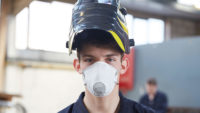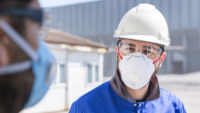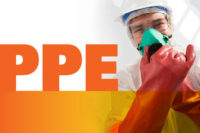OSHA’s respiratory protection FAQs

What materials are respirators made from?
Filtering facepiece (dust masks) are generally made directly from a cloth-like filter material. Chemical cartridge/gas mask respirators can be made from a variety of materials. The most popular facepiece materials are silicone, neoprene, and rubber. In general, rubber and neoprene are rigid, durable materials. Silicone is usually preferred for its comfort, flexibility and ease in cleaning. Full-face respirators are available with strap harnesses or ratchet suspensions. The harness type can be worn under a hard hat, but ratchet suspensions are generally easier to adjust, making donning and doffing easier.
What optional features are available for respirators?
Various features are available to help you customize respirators to suit your employees and the specific hazards they encounter. For example, nose cups reduce lens fogging with full facepiece respirators and lens covers protect the lens from paint, minor chemical splash and scratches.
Spectacle kits are needed when using prescription corrective lenses. The frame mounts into full-face masks, and the prescription lenses are made by the users' optometrist. This allows the wearer to maintain a proper fit and still wear prescription lenses.
How are particulate filters classified?
There are nine classes of particulate filters which are broken down into three series: N, R, and P. Each series (N, R, and P) is available at three efficiency levels: 95%, 99%, and 99.97%. The N series filter is used in environments free of oil mists. The R series filters can be exposed to oil mists, but should only be worn for one work shift. The P filter can be exposed to oil mists for longer than one work shift.
Are there any cautions or limitations when using respirators?
Yes. Each type of respirator can come in several varieties, each with its own set of cautions, limitations, and restrictions of use. Tight-fitting respirators require fit testing to ensure an adequate fit to the face, and cannot be used with facial hair. Certain escape respirators use a nose clip and mouthpiece, which is clenched between your teeth, similar to a snorkel. Some respirators prevent the user from talking while others have speaking diaphragms or electronic communication devices. Every respirator contaminated with hazardous chemicals should be cleaned and decontaminated or disposed of properly.
All respirators require training in order to be properly used. Sometimes you can practice using your own respirator. Some escape respirators come in a package that must remain sealed until use, so you need to be trained using a special “practice” version. Training is extremely important in regard to the storage, maintenance, use, and disposal of the respirator. This information is provided by the supplier of the respirator (i.e., seller, distributor, or manufacturer). If you do not use a respirator correctly, it is very likely that it will not adequately protect you and may even hurt you.
How well does a respirator need to fit me?
If your mask does not make a tight seal all the way around your face when you inhale, you may breathe contaminated air that leaks around the edges of the face seal. Most respirators come in different styles and sizes, and fit different people differently because people's faces have different shapes. You also need training to know how to correctly put the mask on and wear it correctly. This information should be provided by the supplier of the respirator.
The only way to tell if a tight-fitting respirator fits you properly, and is capable of protecting you, is to fit test the respirator. Fit testing can be accomplished a number of different ways and should be done by a health and safety professional before workers wear a respirator in a hazardous environment.
Respirators must be checked for proper fit each time they are donned to ensure they provide adequate protection.
Can I wear a respirator if I have a beard?
Anything that prevents the face mask from fitting tightly against your face, such as a beard or long sideburns, may cause leakage. If your respirator requires a tight fit, you must trim back your beard so that it will not interfere with the face-facepiece seal. If your respirator is a loose-fitting (hooded) positive pressure respirator (e.g., a powered air-purifying respirator, PAPR) then you may have a beard.
If I have the right cartridges/filters for a certain hazard, and my mask fits, will they always protect me against that hazard?
No. Gas masks and respirators reduce exposure to the hazard, but if the exposure is such that it goes beyond what the filter is capable of handling (either because the amount of toxic gas or particles is more than what the filter is designed to handle, or because the exposure lasts longer than what the filter is designed to handle), the filter may not be effective in providing required protection. Also, there may be a small amount of leakage even if the fit of the respirator has been tested. If so, and if there is a large amount of a toxic chemical in the outside air, even that small leakage can be dangerous.
Can anyone wear a respirator?
No. Breathing through a respirator is more difficult than breathing in open air. People with lung diseases, such as asthma or emphysema, elderly people, and others may have trouble breathing. People with claustrophobia may not be able to wear a full facepiece or hooded respirator. People with vision problems may have trouble seeing while wearing a mask or hood (there are special masks for people who need glasses). Employees must be medically evaluated before assigned to use a respirator.
Will my cartridge/filter and respirator mask protect forever?
No. Cartridges, filters, and masks get old. If the filter cartridges are outdated, have been open to the air or are damaged, you may not be protected. Cartridges that contain charcoal or other chemicals for filtering the air should be kept in air-tight packages until use. If cartridges are open or not packed in air-tight packaging, they should not be used. Even cartridges in original packaging have expiration dates that should be checked before purchase and use. Also, over time your mask can get old and break down. Keep your mask in a clean, dry place, away from extreme heat or cold. Inspect it before and after use according to the manufacturer's instructions. Cartridges also have a limited service life; they must be changed periodically during use.
Will a gas mask protect me if there is not enough oxygen in the air?
No. Air-purifying respirators do not provide oxygen. If used in an environment with low oxygen levels, such as in a fire or a confined space, you are in danger of asphyxiation.
Will a gas mask protect me if there is a fire?
Most will not. It's important to read the manufacturer's information if your main concern is to be able to escape from a smoke-filled building. Smoke particles can rapidly clog gas mask filters, and filters with special chemicals are needed to protect against carbon monoxide and other gases that may occur in a fire. Not all gas masks or escape respirators protect against these hazards. Some components, including hoods and facepieces, of many of the gas masks and escape respirators may melt if exposed to a fire.
Once I put on my gas mask, how long will it last?
That depends on how much filtering capacity the respirator has and the amount of hazard in the air – the more chemical or biological hazard in the air (higher concentration), the shorter the time your filter will last. There is no absolute time limit, and it will vary by each respirator model's capacities and the concentration of the hazard.
Source: OSHA
Looking for a reprint of this article?
From high-res PDFs to custom plaques, order your copy today!








